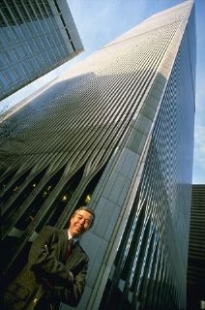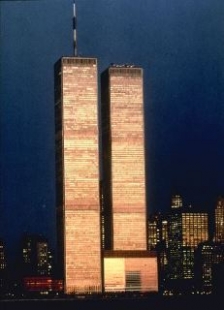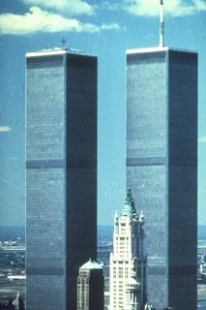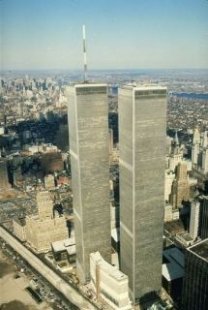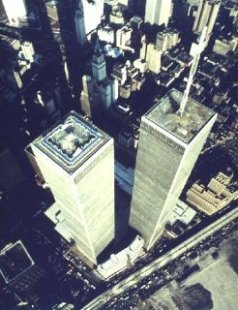
World Trade Center

"They are large buildings, but they are not great architecture."
September 11, 2001, 16:30 CET - destroyed by a terrorist attack. You can read below about how the building attracted terrorists in the past.
On Friday, February 26, 1993, at 12:18 PM, the most horrifying fears of pessimists were realized. A bomb exploded in the World Trade Center (WTC), breached walls, started a fire, and left 50,000 workers and visitors gasping for air as they were plunged into the darkness of the 110-story building. The explosion, which managed to create a crater spanning over five floors in the lower levels of the building, incapacitated the police command center and the central control system, while the emergency evacuation system also failed. Television broadcasts (except one) in New York were interrupted because the daily commute of thousands of people using the ten subway lines converging near WTC was rendered impossible. The deadly blast also necessitated the evacuation of the Empire State Building, where the existence of an explosive device was also reported on the same day. This report later turned out to be false.
The bombing killed 6 people and injured at least 1,000 others. The WTC was closed for a month, and repairs to the building cost $1.1 million. Muslim fundamentalists were subsequently charged with the attack.
On a lighter note: the WTC was chosen for an incredible act by Philippe Petit, a famous French acrobat who walked on a tightrope stretched between the two towers in 1974, receiving support and cheers from onlookers. After his arrest, Petit stated: "When I see three oranges, I have to juggle, and when I see two towers, I have to walk on a wire."
These varied reports illustrate how historical events accumulate in buildings, especially in prominently tall and expensive ones. The story of the WTC began in 1960 when David Rockefeller's efforts aimed to revitalize Lower Manhattan, continuing in 1962 when the land became the official property of the main tenant of the WTC - the Port Authority of New York and New Jersey, which intended to make the WTC home to international importers and exporters.
The most malignant proposal became a pair of towers 415 meters high (the twin brothers - one is 2 meters taller - were soon nicknamed David and Nelson after the Rockefeller brothers). The design was created by a small firm, Minoru Yamasaki (who stood 152 cm tall) and Emmery Roth & Sons, which also worked on New York's Ritz Tower and Pan Am buildings. The monotonous boxy appearance of the towers wrapped in aluminum was not very popular and soon became the target of criticism in the press and on the streets.
Despite public misunderstanding, the WTC became a much more recognizable symbol of New York than the nearby Statue of Liberty. The WTC also brought many design innovations. Robert Stern noted in his book New York 1960: "Rather than a typical frame building covered with stone or glass, it was a massive steel lattice, functioning almost like a jointed wall structure, primarily supported by closely spaced exterior columns, which, along with their intersecting elements, create true squares or Vierendeel trusses." The WTC also introduced the Skylobby operating system - utilizing local and express elevator zones.
Very tall buildings evoke strong concerns and feelings. Acrophobia (fear of high places), batophobia (fear of high objects), and anablephobia (fear of gazing at high places) are known to many people. Nevertheless, the perception of certain skyscrapers, such as the magical Chrysler Building or the Eiffel Tower, leads to reflection. In the hands of the media, indelibly influenced by the bombing of the WTC and the later tragedy in Oklahoma City, which were weeks of leading headlines in newspapers and television screens, the possibility of negative portrayals of skyscrapers leading to collective imagination arises. Just one building can reflect an entire city - even an entire culture.
Ada Louise Huxtable (1973)
September 11, 2001, 16:30 CET - destroyed by a terrorist attack. You can read below about how the building attracted terrorists in the past.
On Friday, February 26, 1993, at 12:18 PM, the most horrifying fears of pessimists were realized. A bomb exploded in the World Trade Center (WTC), breached walls, started a fire, and left 50,000 workers and visitors gasping for air as they were plunged into the darkness of the 110-story building. The explosion, which managed to create a crater spanning over five floors in the lower levels of the building, incapacitated the police command center and the central control system, while the emergency evacuation system also failed. Television broadcasts (except one) in New York were interrupted because the daily commute of thousands of people using the ten subway lines converging near WTC was rendered impossible. The deadly blast also necessitated the evacuation of the Empire State Building, where the existence of an explosive device was also reported on the same day. This report later turned out to be false.
The bombing killed 6 people and injured at least 1,000 others. The WTC was closed for a month, and repairs to the building cost $1.1 million. Muslim fundamentalists were subsequently charged with the attack.
On a lighter note: the WTC was chosen for an incredible act by Philippe Petit, a famous French acrobat who walked on a tightrope stretched between the two towers in 1974, receiving support and cheers from onlookers. After his arrest, Petit stated: "When I see three oranges, I have to juggle, and when I see two towers, I have to walk on a wire."
These varied reports illustrate how historical events accumulate in buildings, especially in prominently tall and expensive ones. The story of the WTC began in 1960 when David Rockefeller's efforts aimed to revitalize Lower Manhattan, continuing in 1962 when the land became the official property of the main tenant of the WTC - the Port Authority of New York and New Jersey, which intended to make the WTC home to international importers and exporters.
The most malignant proposal became a pair of towers 415 meters high (the twin brothers - one is 2 meters taller - were soon nicknamed David and Nelson after the Rockefeller brothers). The design was created by a small firm, Minoru Yamasaki (who stood 152 cm tall) and Emmery Roth & Sons, which also worked on New York's Ritz Tower and Pan Am buildings. The monotonous boxy appearance of the towers wrapped in aluminum was not very popular and soon became the target of criticism in the press and on the streets.
Despite public misunderstanding, the WTC became a much more recognizable symbol of New York than the nearby Statue of Liberty. The WTC also brought many design innovations. Robert Stern noted in his book New York 1960: "Rather than a typical frame building covered with stone or glass, it was a massive steel lattice, functioning almost like a jointed wall structure, primarily supported by closely spaced exterior columns, which, along with their intersecting elements, create true squares or Vierendeel trusses." The WTC also introduced the Skylobby operating system - utilizing local and express elevator zones.
Very tall buildings evoke strong concerns and feelings. Acrophobia (fear of high places), batophobia (fear of high objects), and anablephobia (fear of gazing at high places) are known to many people. Nevertheless, the perception of certain skyscrapers, such as the magical Chrysler Building or the Eiffel Tower, leads to reflection. In the hands of the media, indelibly influenced by the bombing of the WTC and the later tragedy in Oklahoma City, which were weeks of leading headlines in newspapers and television screens, the possibility of negative portrayals of skyscrapers leading to collective imagination arises. Just one building can reflect an entire city - even an entire culture.
The English translation is powered by AI tool. Switch to Czech to view the original text source.
0 comments
add comment


